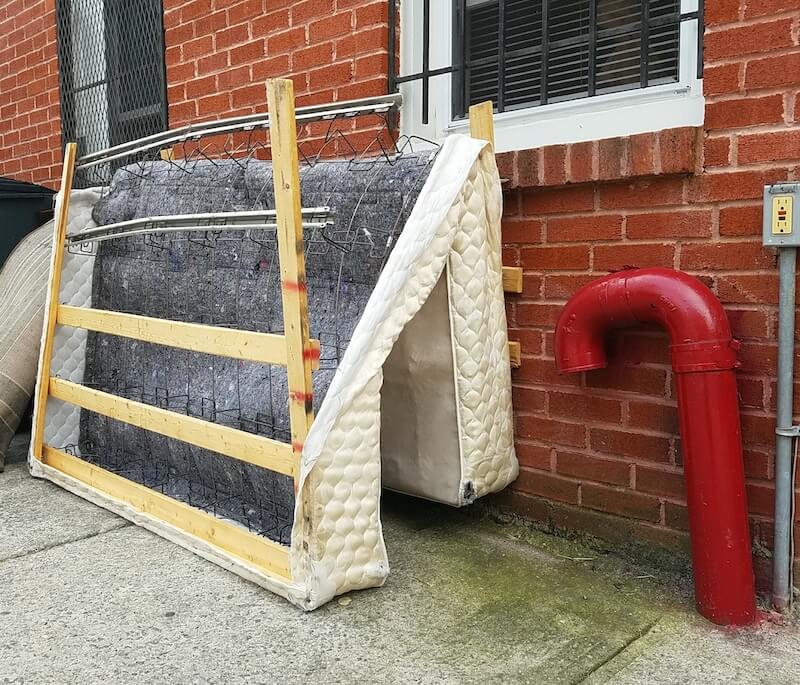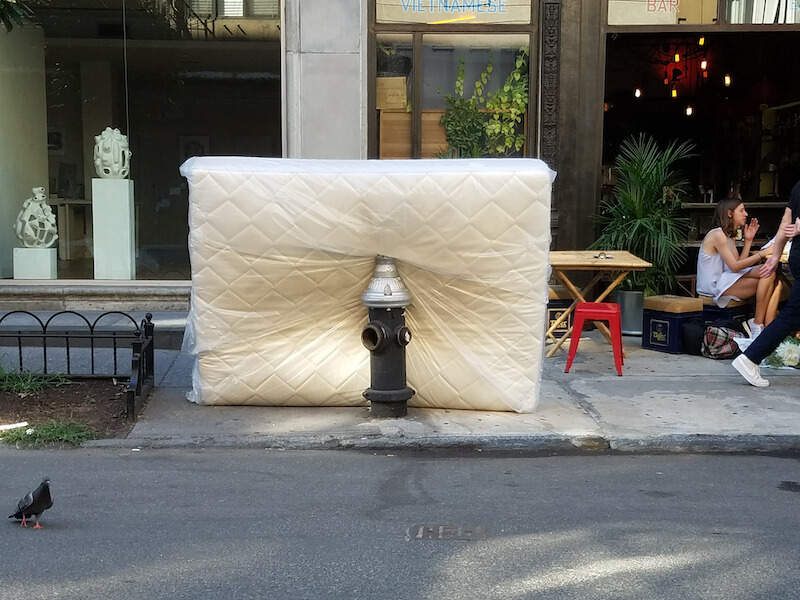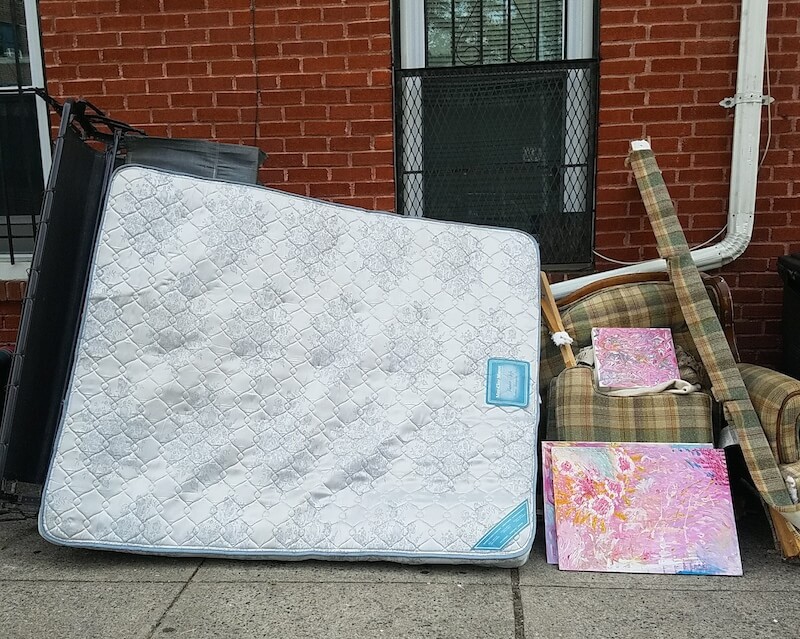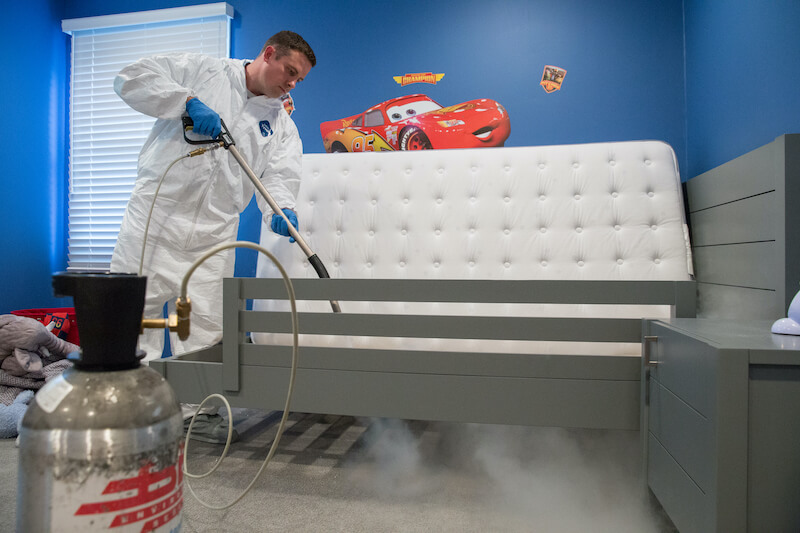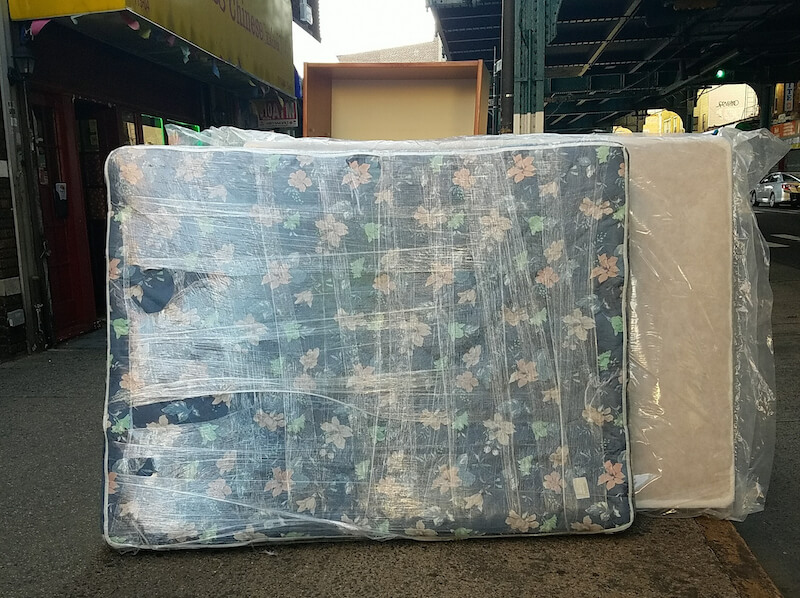There is perhaps no insect more hated than the bed bug. Your home—and the room where you sleep—is supposed to be a place of comfort and security. That’s a little tricky when you’re sharing your space with the world’s grossest bloodsuckers.
A bed bug infestation can be hard to detect, and equally hard to eradicate. That’s not to mention the embarrassing social stigma they come with! Just tell a friend you’re dealing with these pests and see how quickly they run screaming from the room…
Bed bugs can turn your cozy, warm apartment into the set of a low-budget horror movie. And yet—there’s hope! What can feel like an insurmountable, never-ending disaster is actually a manageable pain in the ass. Promise.
If your apartment is infiltrated by these pests, you’re not alone! You join a huge club of sufferers, past and present.
Bed bugs are so ubiquitous, in fact, that they’ve seeped into our popular culture (not to mention children’s nursery rhymes). They’ve inspired plots on sitcoms from 30 Rock to Broad City. The psycho killer in Patricia Highsmith’s 1957 novel Deep Water is such a loon that he breeds bed bugs in his garage, and lets them bite him for the sake of science. Yuck times 10,000.
Below, we’ll crawl deep into everything you need to know about bed bugs: how to avoid them, how to detect them, and how to get them out of your life.
If you’re crushed for time, feel free to skip ahead to the sections on finding signs of bed bugs; bed bug bites; pest inspections; types of treatments; and how to avoid bringing bed bugs with you to a friend’s house.
One important fact to note: Bed bug treatments are not covered by most renters insurance, including Lemonade’s. In many cases, however, your landlord is legally responsible for eradicating the problem (and paying for it).
How do you get bed bugs?
Pest professionals will be the first to remind you that bed bugs aren’t a byproduct of uncleanliness, and they don’t have a class bias. The bed bug will be just as at home in a fancy hotel or Manhattan brownstone as they are in the most rundown tenement.
Bed bugs are known as “hitchhikers,” which means that they’re keen to travel from one place to another. Did you go see the new Christopher Nolan movie at the multiplex and decide to shove your unzipped backpack underneath your seat? Did you spend a few nights at a high-volume Airbnb rental, leaving your suitcase next to the bed?
These insects can also live in less obvious places: baseboards; used furniture other than beds; electrical outlets; the crevices of that picture frame you bought at the Goodwill; the spines of hardcover books.
In fact, once you learn a bit about where bed bugs hide, you run the risk of seeing every place as a potential hiding spot for tiny bloodsuckers.
Once even a single bug is introduced into an apartment building with multiple units, an untreated problem can spread—across the hall, or between floors, using heating pipes to travel. Hold that gross thought: we’ll return to it later.
What do bed bugs look like? What are the signs of bed bugs?
One of the more maddening things about bed bugs is how sneaky they are, and how well they avoid simple detection.
There’s a common myth that bed bugs are somehow so small that they’re essentially invisible. While the smallest bed bug nymphs are very tough to spot, you don’t need a microscope to see bed bugs. That said, they do secret themselves away in places where you’re not likely to find them, unless you’re looking.
So what hiding places should you take a peek at, and what are the signs of bed bugs?
Your mattress is a good enough place to start. Inspect the seams, corners, and other areas for live bugs, the shed “skins” of bugs (their exoskeletons), or suspicious black markings that are actually a bed bug’s fecal droppings. The latter are often described as looking like a black marker tip bled into the fabric.
Sometimes you might also see blood spots or stains on your actual bedding. As promised, we’re not embedding any of these gnarly images here, but feel free to click the links to see real-life examples (or dive into Google’s endless array of stomach-turning pics).
It’s equally important to closely inspect your box spring, if you have one—or any platform, bed frame, or support that your mattress rests on. Use a credit card to poke at any cracks or crevices in the box spring, and a flashlight to get a better look.
From there, expand your search outward from the bed: side tables, other furniture, framed objects on the walls, your bed’s headboard.
But keep in mind that bed bugs can and will set up shop in places other than your bedroom. If you spend a lot of time lounging on your living room couch watching Netflix—plenty of time for a few parasites to take a nibble—then your problem might be localized there.
Won’t I just know whether I have bed bugs based on whether I’m getting weird bites?
If only it were that easy, but…Sigh. Human skin is weird, and a lot of random stuff can affect it.
While the popular consensus is that bed bug bites have a specific appearance, and most often appear in rows of three (aka a “breakfast, lunch, and dinner” pattern), the truth is that it’s basically impossible to confirm a bed bug infestation based on whatever itchy welts, bumps, or rashes you might be finding on yourself.
Also, to complicate things, a lot of people don’t even react to bed bug bites, and therefore have no idea they’re getting bitten every night. Depending on the study, over 25% of people below the age of 65 might not react to bites, with over 40% of those over the age of 65 being non-reactive.
Should I get a pest control professional to come inspect for bed bugs?
If you have reason to think you’re dealing with bed bugs, but can’t find any conclusive proof yourself, it might make sense to hire an exterminator to come do their own inspection.
Your landlord might be contracted to use a particular service, but make sure they have actual experience dealing with bed bugs—these pests involve a very different attack plan than cockroaches or ants.
Humans, of course, make mistakes, and it’s possible that even a competent exterminator might miss a low-level bed bug problem. Bed bugs can also hide out in creative spots—like electrical outlets—making traditional inspection methods difficult.
One additional option would be to hire a K-9 inspection service, who’ll send a specially trained dog and handler to your property. These pups are talented when it comes to sniffing out hard-to-spot bed bug populations—but it’s also possible that they might fail to alert in the presence of an infestation, or alert falsely or ambiguously when you actually don’t have bed bugs.
The general rule of thumb is not to take a positive K-9 inspection result at face value, until further material confirmation of the bugs can be found in the apartment. Many K-9 inspectors also operate independently of extermination services, to prevent any cynical conflicts of interest. Keep in mind that this can all start to get expensive, and your management company or landlord might not be willing to spring for more than a basic inspection.
Okay, so it’s two o’clock in the morning and my leg started itching so I jumped out of bed and flipped over my mattress and found what look like adult bed bugs burrowed into the seams and what do I do now, besides start moaning in despair?
“Many bed bug victims’ first instincts are to get the jitters and then figure out ways to get rid of these little vampires as quickly as possible,” explains Glenn Waldorf, of the New Jersey-based bed bug exterminators Bell Environmental.
“Peoples’ minds race and they think, ‘Should I throw out our furniture? How can I ever sleep in this bed again? I’ll just move to the couch. Maybe I should spray the room with cleaning supplies, chemicals and/or bleach—that will kill them!’ Please don’t do any of those things. These actions can make your bed bug problem worse and harder to resolve.”
The last thing you want to do is freak out and decide to drag your infested mattress out of your apartment and to the curb.
First of all, there’s zero guarantee that this will solve the problem. It most likely will turn a manageable dilemma into a sprawling headache—any bugs hiding out on your bed or bedding could easily be shaken off in your building’s stairwell or hallways, free to scurry away and set up new base camps in your neighbors’ apartments.
Waldorf says to “take a deep breath” and remain calm. Photograph whatever insects you find, or trap them for identification. If you can’t figure out what you’re looking at, there are entomologists online who are often willing to identify bugs, or suspicious markings that might be fecal droppings.
If you indeed have a problem on your hands, call a pest control professional who can come draft a proper treatment plan—one that likely might not even involve tossing out your bed or other furniture.
Remember: Rash decisions will come back to haunt you. No one wants to go to sleep knowing that they’re sharing an infested room with bed bugs, but wait until the pros arrive to make any big moves.
If you do decide to dispose of an infected mattress or boxspring at any point in time, do yourself and your building mates a favor: Wrap it up very, very securely in a special plastic bag before removing it from your apartment.
My landlord is reluctant to help me with my bed bug infestation, but he finally agreed to hire some random exterminator who seems pretty incompetent...
While your landlord may be legally required to deal with your bed bug infestation, that doesn’t guarantee that they’ll hire a competent pest control company. You’ll want to avoid having a lazy technician from A1 Super Great Bug Killerz showing up at your door, eager to spray toxic insecticides all over your apartment without explaining what the overall battle plan is.
Here’s Waldorf of Bell Enviromental’s short list of questions to ask your management company or landlord:
- How fast can they arrange a thorough inspection of your apartment, from a legitimate company?
- Will the inspectors also check any neighboring units (in case that’s the original source of the infestation?)
- How are you supposed to help the treatment succeed, by preparing your home and removing clutter?
- Will the treatment be mainly non-chemical—as it should be?
- Will the treatment program include two visits, which is necessary because of the biology of these insects?
How do you kill bed bugs?
Once you’ve got the green light to work with a trustworthy pest control company, you’ll have to decide which type of treatment you’re comfortable with.
There are many, from chemical treatments to extermination efforts that use extreme heat or extreme cold. Many companies will mix tactics for a hybrid method that includes both physical and chemical solutions.
Any treatment will also involve a lot of legwork on your part, helping to prepare your apartment and your stuff according to specific directions your pest control provider will give you. This will likely involve vacuuming, decluttering, running clothes through the dryer on medium-high heat, and storing certain belongings in sealable plastic bags.
Whatever you do, don’t go the D.I.Y. home remedy route of using products, essential oils, aerosols, or off-brand insecticides you might find at Home Depot or on Amazon.
Certain things that might seem like a cheap, nuclear option—such as so-called “bug bombs,” or foggers—will also only cause grief. “These products usually don’t work on bed bugs,” Waldorf says, “and worse, can scare bugs into hiding in an out-of-the-way place, like your bathroom.”
Some pest control companies will lay down pesticides that kill bed bugs. Others will bring heavy equipment into your home for heat treatment, generating high temperatures throughout the entire living space so that bugs at various life stages will be killed off.
Bell Environmental uses a non-toxic technology known as InstantFreeze—as you might guess, it involves blasting furnishings, bed frames, box springs, and other hiding places and belongings with ultra-cold dry ice spray, killing bugs.
This tactic is effective and convenient, plus it provides peace and mind if you have kids in the house. InstantFreeze can also be used on sensitive items, like oil paintings or electronics. The downside? It’s comparably pricey, to say the least.
There are almost as many treatment options as there are bed bug hiding places. Caulk can be applied to cracks in walls, ceiling, baseboards, or around pipes, to eliminate avenues for bed bugs to travel in or out. Organic powders, like diatomaceous earth, might be useful in some instances (and when properly applied).
How can I avoid bringing bed bugs with me to work, or to a friend’s apartment?
As if they’re not bad enough, bed bugs are also fond of traveling with you when you leave your apartment. Be cognizant of what you bring with you when you head out the door.
While you’re in the process of treatment, consider keeping your clothing and other belongings in sealable plastic bags, like these. Don’t leave shoes, purses, or other items near your bed or on other furniture.
And speaking of how to avoid letting this pest problem spread: Talk to your neighbors if you’re experiencing a bed bug issue!
You might be embarrassed or ashamed, but you shouldn’t be… and for all you know, the bed bugs may have come from a neighbor who is himself too embarrassed or ashamed to bring it up. Proper treatment of bed bugs requires dealing with issues in any neighboring apartments, so that the pests don’t simply ping-pong from one location to another.
Are there traps, monitors, or other gadgets that are helpful for bed bug control?
Unsurprisingly, there’s a whole cottage industry dedicated to anti-bed-bug doodads and equipment. There are glue traps to place in key locations around your bed and bedroom; “active” monitors that release CO2 to mimic a human presence, drawing out pests from hiding spots; and round, plastic interceptors—like those made by ClimbUp—which can be placed under furniture legs, intended to capture any bugs.
Mattress encasements are useful for…well, encasing your mattress, and making it difficult for any bugs to tuck themselves into its seams or crevices. (Just make sure that the encasement itself doesn’t rip—like if your cat loves to claw your bed.)
None of these solutions are perfect. If you’re feeling paranoid and anxious, for instance, ClimbUps or other interceptors might compound the problem—it’s no fun to obsessively check multiple monitors for signs of bugs… and it’s pretty easy to mistake a common pest, like a book louse, for a bed bug nymph.
Find the right solution that works for your situation, and your mental health. If you travel often, and are worried about picking up bed bugs from a hotel room or Airbnb, you might consider a heating device that can treat your luggage, hopefully killing any live bed bugs or eggs that might have joined you along the way.
I’m pretty sure I’ve gotten rid of my bed bug problem but I can’t stop thinking about it. How the hell am I ever going to sleep comfortably again, let alone go to a movie theater or stay at a hotel?
Ask most people who have struggled with a bed bug infestation in the past what it was like, and they’re likely to lean on an overblown cliche: “I still have PTSD from dealing with it!”
In fact, some pest professionals have a name for the anxiety and worry that these bloodsuckers generate—they call them “head bugs.”
Bed bug infestations can be a particularly worrisome problem for those who struggle with obsessive-compulsive disorder. OCD thrives on doubt, and a corresponding need for reassurance.
With bed bugs, it can be maddeningly hard to determine if you even have a problem—and then to confirm if the problem has gone away after treatment. This can lead to a spiral of unnecessary inspections, panic, and anxious Googling.
We won’t lie: The process of dealing with bed bugs will suck (har, har), and might temporarily feel like another full-time job on top of your actual full-time job. But with perseverance and attention to detail, you’ll get through it.
“If you work with a capable professional, after a couple of weeks of inconvenience and not having company over—right now we’re all holding off on that—your life will resume as it was before,” says Glenn Waldorf of Bell Environmental.
On the other side of your Great Bed Bug Disaster, you’ll have a newfound appreciation for a restful night… and you might think twice about lugging home that mid-century modern couch that someone just threw out for no good reason.
Sleep tight, and… you know.

